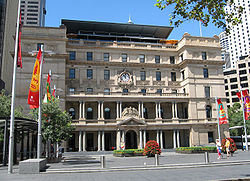
Customs House, Sydney
Encyclopedia


Customs
Customs is an authority or agency in a country responsible for collecting and safeguarding customs duties and for controlling the flow of goods including animals, transports, personal effects and hazardous items in and out of a country...
Service until 1990. Ownership was then transferred from the Commonwealth Government of Australia
Government of Australia
The Commonwealth of Australia is a federal constitutional monarchy under a parliamentary democracy. The Commonwealth of Australia was formed in 1901 as a result of an agreement among six self-governing British colonies, which became the six states...
to the City of Sydney Council
City of Sydney
The City of Sydney is the Local Government Area covering the Sydney central business district and surrounding inner city suburbs of the greater metropolitan area of Sydney, Australia...
in 1994, when it became a venue for exhibitions and private functions. After being refurbished in 2003, it has also become the new home of the City of Sydney Library
City of Sydney Library
The City of Sydney Library is a network of eight branch libraries and two 'library links', locatedwithin the City of Sydney Council administrational area.- History :...
.
The ground floor of the building houses a 4.2m x 9.5m scale model of Sydney's CBD
Central business district
A central business district is the commercial and often geographic heart of a city. In North America this part of a city is commonly referred to as "downtown" or "city center"...
, viewed through a glass floor. The model was built by Modelcraft in 1998 and weighs one tonne. Images of the various versions of the building across its history are also displayed.
History
People of the EoraEora
The Eora are the Aboriginal people of the Sydney area, south to the Georges River, north to the Hawkesbury River, and west to Parramatta. The indigenous people used this word to describe where they came from to the British. "Eora" was then used by the British to refer to those Aboriginal people...
tribe are said to have witnessed from the site, in 1788, the landing of the First Fleet
First Fleet
The First Fleet is the name given to the eleven ships which sailed from Great Britain on 13 May 1787 with about 1,487 people, including 778 convicts , to establish the first European colony in Australia, in the region which Captain Cook had named New South Wales. The fleet was led by Captain ...
. Convict David O'Connor was hanged on the site in 1790 and it is said that his ghost haunts the Customs House to this day, offering people rum.
The driving force behind the construction of the original sandstone
Sydney sandstone
Sydney sandstone is the common name for Sydney Basin Hawkesbury Sandstone, historically known as Yellowblock, is a sedimentary rock named after the Hawkesbury River north of Sydney, where this sandstone is particularly common....
edifice on Circular Quay was Colonel John George Nathaniel Gibbes (1787-1873), the Collector of Customs for New South Wales for a record term of 25 years from 1834 to 1859. Colonel Gibbes persuaded the Governor of NSW, Sir George Gipps, to begin construction of the Customs House in 1844 in response to Sydney's growing volume of maritime trade. The building project also doubled as an unemployment relief measure for stonemasons and laborers during an economic depression which was afflicting the colony at the time.
The two-storey Georgian
Georgian architecture
Georgian architecture is the name given in most English-speaking countries to the set of architectural styles current between 1720 and 1840. It is eponymous for the first four British monarchs of the House of Hanover—George I of Great Britain, George II of Great Britain, George III of the United...
structure was designed by Mortimer Lewis
Mortimer Lewis
Mortimer William Lewis , was an English architect and surveyor who migrated to Australia and became Colonial Architect in the state of New South Wales from 1835 to 1849. Lewis was responsible for designing and overseeing many government buildings in Sydney and rural New South Wales, many of which...
and featured 13 large and expensive windows in the facade to afford a clear view of shipping activity in Sydney Cove
Sydney Cove
Sydney Cove is a small bay on the southern shore of Port Jackson , on the coast of the state of New South Wales, Australia....
. Colonel Gibbes, who dwelt opposite Circular Quay on Kirribilli Point, was able to watch progress on the Customs House's construction from the verandah of his private residence, Wotonga House (now Admiralty House
Admiralty House
Buildings called Admiralty House include:*Admiralty House, Halifax, former Admiral's Residence now the Maritime Command Museum* Admiralty House, Mount Pearl, aka Admiralty House Museum & Archives Buildings called Admiralty House include:*Admiralty House, Halifax, former Admiral's Residence now the...
).
The Customs House opened for business in 1845 and replaced cramped premises at The Rocks
The Rocks, New South Wales
The Rocks is an urban locality, tourist precinct and historic area of Sydney's city centre, in the state of New South Wales, Australia. It is located on the southern shore of Sydney Harbour, immediately north-west of the Sydney central business district...
. It was partially dismantled and expanded to three levels under the supervision of the then Colonial Architect, James Barnet
James Barnet
James Johnstone Barnet was the Colonial Architect for New South Wales from 1862 - 1890.-Life and career:Barnet was born at Almericlose, Arbroath, Scotland. The son of a builder, he was educated at the local high school...
, in 1887. Various additions were made over the next century, particularly during the period of the First World War, but some significant vestiges of the original Gibbes-Lewis building remain.
External links
- Customs House (official website of the building)
- Sydney Architecture (historic photos and details)

